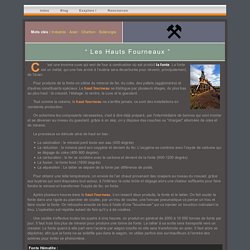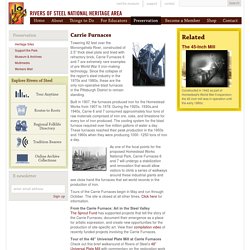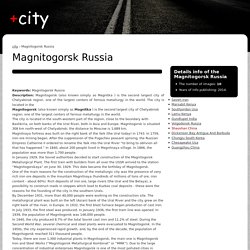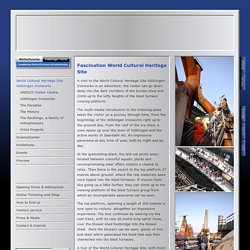

Patrimoine Sidérurgique. C'est une énorme cuve qui sert de four à combustion où est produit la fonte.

La fonte est un métal, qui une fois arrivé à l'aciérie sera décarburée pour devenir, principalement, de l'acier. Pour produire de la fonte on utilise du minerai de fer, du coke, des pellets (agglomérés) et d'autres constituants spéciaux. Le haut fourneau se distingue par plusieurs étages, du plus bas au plus haut : le creuset, l'étalage, le ventre, la cuve et le gueulard. Tout comme la cokerie, le haut fourneau ne s'arrête jamais, ce sont des installations en constante production.
On achemine les composants nécessaires, c'est à dire déjà préparé, par l'intermédiaire de bennes qui vont monter et se déverser au niveau du gueulard, grâce à un skip, on y dispose des couches ou "charges" alternées de coke et de minerai. Le processus se déroule ainsi de haut en bas : La calcination : le minerai perd toute son eau (400 degrés) La réduction : le minerai perd son oxygène et devient du fer. Fonte Hématite : Agglomération : Braddock Pennsylvania. Towering 92 feet over the Monongahela River, constructed of 2.5" thick steel plate and lined with refractory brick, Carrie Furnaces 6 and 7 are extremely rare examples of pre World War II iron-making technology.

Since the collapse of the region's steel industry in the 1970s and 1980s, these are the only non-operative blast furnaces in the Pittsburgh District to remain standing. Built in 1907, the furnaces produced iron for the Homestead Works from 1907 to 1978. During the 1920s, 1930s,and 1940s, Carrie 6 and 7 consumed approximately four tons of raw materials comprised of iron ore, coke, and limestone for every ton of iron produced. The cooling system for the blast furnace required over five million gallons of water a day. These furnaces reached their peak production in the 1950s and 1960s when they were producing 1000 -1250 tons of iron a day. Tours of the Carrie Furnaces begin in May and run through October. Dunkerque.
Images Site Web pour cette image dunkerque Stock Videos | dunkerque Stock Footage | Framepool footage.framepool.com Recherche par imageImages similaires Les images peuvent être soumises à des droits d'auteur.

Gary Indiana. Magnitogorsk Russia. City › Magnitogorsk Russia Keywords: Magnitogorsk Russia Description: Magnitogorsk (also known simply as Magnitka ) is the second largest city of Chelyabinsk region. one of the largest centers of ferrous metallurgy in the world.

The city is located in the Magnitogorsk (also known simply as Magnitka ) is the second largest city of Chelyabinsk region. one of the largest centers of ferrous metallurgy in the world. The city is located in the south-western part of the region, close to the boundary with Bashkiria, on both banks of the Ural River, both in Asia and Europe. Magnitogorsk is situated 308 km north-west of Chelyabinsk; the distance to Moscow is 1,689 km. Magnitnaya fortress was built on the right bank of the Yaik (the Ural today) in 1743. In January 1929, the Soviet authorities decided to start construction of the Magnitogorsk Metallurgical Plant. By December 1931, more than 40,000 people were working on the construction site. Photogallery Magnitogorsk Russia: Ostrava République tchèque. Uckange - U4. Haut-fourneau U4 Symbole fort du patrimoine industriel de la vallée de la Fensch, le haut-fourneau U4 est le dernier des six hauts-fourneaux de l’usine d’Uckange.

Témoin du formidable essor économique de toute la région dans les années 1960-1980, ce « monstre de fer » s’est éteint en 1991 pour revenir à la vie et s’ouvrir au public en 2007, après des années de travaux. Il est l’un des rares témoignages de la sidérurgie du XXe siècle aujourd’hui conservé en France. Classé à l’inventaire supplémentaire des monuments historiques par le Ministère de la Culture, le Parc du haut-fourneau U4 s’étend sur une surface de 12 hectares d’anciennes friches industrielles, avec comme points culminants la cheminée à 82 mètres et la « nacelle » du haut-fourneau à 71 mètres. Le projet culturel Symbole d’une histoire forte, décor à l’esthétique saisissant, le Parc du haut-fourneau U4 devient lieu et source de création, d’inspiration et de respiration.
Festival Rock’n’Fer #6 Dimanche 6 septembre - 15h. Völklinger Hütte Deutschland. A visit to the World Cultural Heritage Site Völklingen Ironworks is an adventure: the visitor can go down deep into the dark corridors of the burden shed and climb up to the lofty heights of the blast furnace viewing-platform.

The multi-media introduction to the sintering-plant takes the visitor on a journey through time, from the beginnings of the Völklingen Ironworks right up to the present day. From the roof of the ore shed, a view opens up over the town of Völklingen and the active works of Saarstahl AG. An impressive panorama at any time of year, both by night and by day. At the granulating-plant, the laid out picnic area, located between colourful aquatic plants and uncompromising steel offers visitors a chance to relax. Then there is the ascent to the top platform 27 metres above ground: where the raw materials were once tipped into the blast furnaces. The top platform, spanning a length of 200 metres is now open to visitors: altogether an impressive experience.